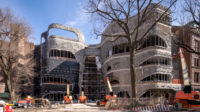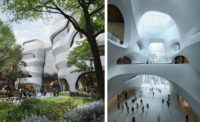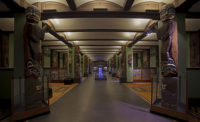Today, New York’s American Museum of Natural History (AMNH) revealed new details about its plans for the Richard Gilder Center for Science, Education, and Innovation—a 235,000-square-foot expansion and renovation designed by Studio Gang Architects.
At a press conference, Ellen Futter, the institution’s president, made the case for the $340 million project, citing pressing issues such as climate change, habitat and species loss, and threats to human health. “In the post-truth era,” she said, “the museum’s role in presenting scientific evidence has never been more critical.”
The new Gilder Center is intended to support AMNH’s educational and research initiatives with facilities such as an immersive “Invisible Worlds” theater focused on microscopic life forms, a dedicated space for its popular living butterfly exhibit, and new classrooms and learning labs. But it also aims to improve circulation and relieve congestion inside the mazelike museum, which comprises more than 25 contiguous structures, including the original wing by Calvert Vaux and J. Wrey Mould (1877) and Polshek Partnership’s Rose Center for Earth and Space (2000).
Jeanne Gang, Studio Gang founding principal, refers to Gilder as an “innie,” meaning it will protrude only slightly from the AMNH’s rear facade, facing Columbus Avenue, with a bowed granite-clad facade and a revamped entrance. But the new center will penetrate deep inside the museum’s fabric. This strategy will help conserve the green space and stately trees of the public park that surrounds the museum. The arrangement, with little new building envelope, also provides a high degree of thermal buffering and self-shading.
Inside, the new center’s main civic space will be an atrium-like exhibition hall with curvaceous concrete walls that resemble caverns and canyons shaped by hydrologic flows, explained Gang. The skylit hall will drive daylight into the museum and link the main entrance on Central Park West with the new Columbus Avenue entrance on the opposite facade. In all, the addition and renovation will touch 10 existing buildings and create 30 new connection points over its five levels. Three structures will be demolished to accomplish this.
In addition to making spatial connections, the project also aspires to connect visitors with previously hidden aspects of the museum. For example, one of the main features of the new exhibition hall will be a glass-enclosed, multi-level “collections core,” which will house more than 3.9 million specimens and artifacts. The objects, including fossils, bees, and meteorites, had been stored out of view of the public. But after the project is complete they will be visible from multiple vantage points, including walkways that span the hall, explained Ralph Appelbaum, the project’s exhibit designer. “It will provide the most unique link to nature that any city has,” he said.
The project was approved by New York’s Landmark’s Preservation Commission in October and is slated to open in 2020 to coincide with the museum’s 150th anniversary. So far, $277 million has been raised from both public and private sources.














Post a comment to this article
Report Abusive Comment